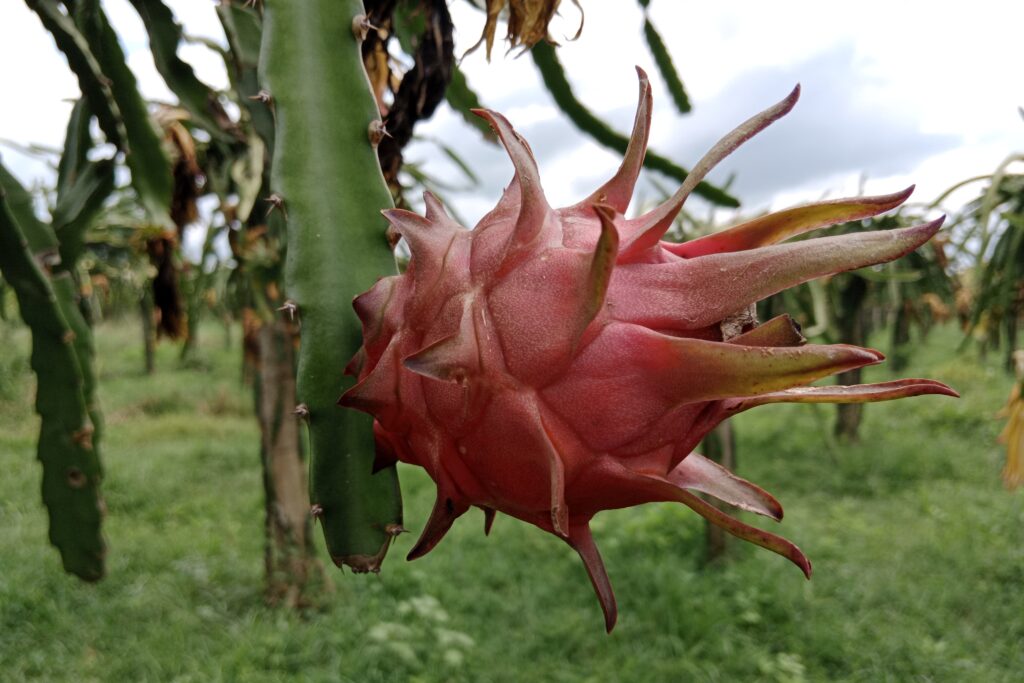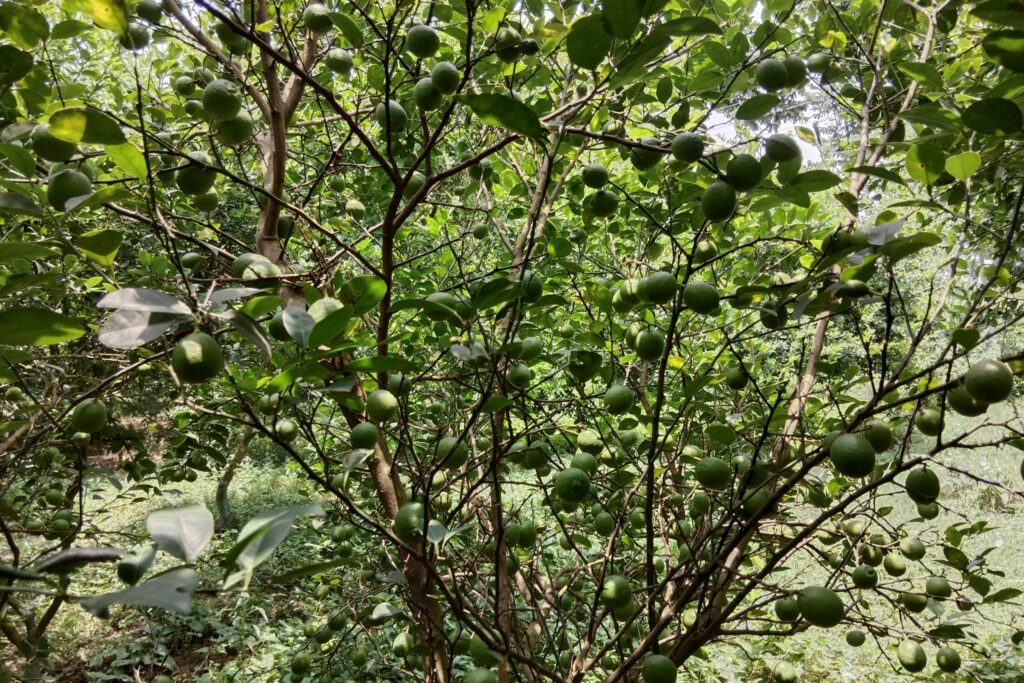Carrot Farming
Carrot farming offers a lucrative opportunity with a net profit of 74,000 NRs. per acre, translating to an impressive 61.67% profit margin and a cost-to-income ratio of just 0.38, indicating that only 38% of the total income is spent on production costs. Key expenses include land preparation (15,000 NRs.) and fertilizers/manure (7,000 NRs.), with labor and irrigation contributing moderately to the overall costs.
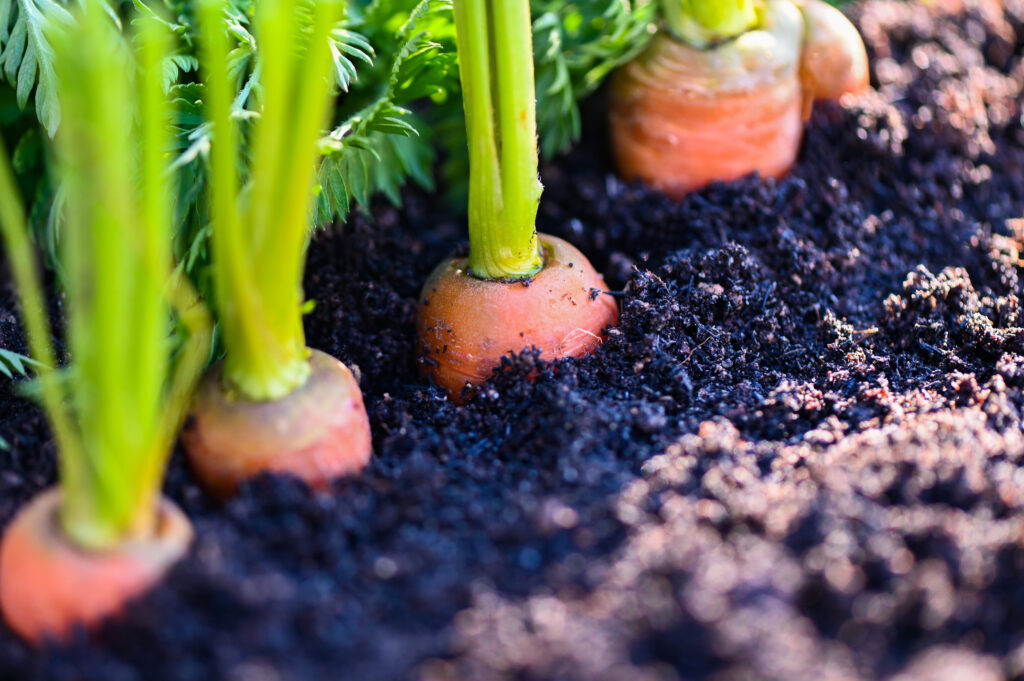
With a production of 8,000 kg per acre sold at 15 NRs. /kg, the revenue amounts to 120,000 NRs., significantly surpassing the break-even yield of 3,067 kg. This yield, which is 2.6 times higher than the break-even point, highlights the low financial risk and high profitability of carrot farming. Such a robust return makes the carrot farming profit per acre a compelling indicator of its economic viability for farmers.
Land Preparation
Carrots require deep, loose, and well-drained soil to promote unimpeded root development, achieved through systematic land preparation beginning with thorough plowing 2–3 times to create a fine, crumbly tilth.
This is followed by leveling the soil to ensure uniform irrigation and prevent waterlogging, alongside meticulous debris removal to eliminate stones, weeds, or obstructions that could deform roots.
For compacted soils, incorporating organic amendments such as compost or well-rotted manure enhances aeration, drainage, and structural friability, creating optimal conditions for robust carrot growth and yield.
Soil Type
Carrots thrive in a variety of soil types, but optimal commercial cultivation requires deep, loose, well-drained soils rich in organic matter, with loamy or sandy loam textures combined with ample humus being ideal. A slightly acidic to neutral pH range of 5.5–6.5 is recommended for maximizing yield, though soils with pH levels up to 7.0 can still support growth; excessively alkaline or acidic soils, however, are unsuitable as they hinder crop development and productivity.
Climatic Requirements
Carrots thrive in cool climatic conditions, with an optimal temperature range of 15°C–20°C, as excessive heat can lead to fibrous, pale, or bitter roots, compromising quality. While they require full sun exposure for vigorous growth, partial shade is tolerated in regions with intense summer heat to mitigate stress and prevent premature bolting.
Seasonality plays a critical role, with winter or cooler months being ideal for cultivation, as prolonged cool weather enhances root sweetness, texture, and color development. Extended exposure to temperatures above 25°C may accelerate foliage growth at the expense of root development, while frost-prone conditions should be avoided to prevent damage. Balancing temperature, light, and seasonal timing ensures optimal yield and superior flavor in carrot production.
Major Cultivars
Main Varieties
| Variety Name | Color/Root Description | Length | Diameter | TSS (%) | Days to Harvest | Yield (qtl/acre) | Key Features/Notes |
| PC 34 | Red color, dark green leaves | 25 cm | 3.15 cm | 8.8 | 90 | 204 | – |
| Punjab Black Beauty | Purple-black roots, dark green leaves | – | – | 7.5 | 93 | 196 | Rich in anthocyanins and phenols (anti-cancer). Used for salads, juice, pickle, Kanji. |
| Punjab Carrot Red | – | – | – | – | – | 230 | – |
| Pusa Kesar | Red color | – | – | – | 90–110 | 120 | Developed by IARI, New Delhi. |
| Pusa Meghali | Orange color | – | – | – | – | 100–120 | Developed by IARI, New Delhi. |
| New Kuroda | – | – | – | – | – | – | Hybrid is suitable for plains and hilly areas. |
Exotic Varieties by Country
| Country | Varieties |
| USA | Red Cored Chantenay, Danvers Half Long, Imperator |
| New Zealand | Akaroa Long Red, Spring Market Improved, Wanganui Giant |
| Japan | Suko |
| Belgium | Belgium White |
| Netherlands | Early Horn |
| Australia | Red Elephant, Western Red, Yellow |
| France | Chantenay, Nantes, Oxheart |
Seed Rate
For sowing one acre of land, a seed rate of 4–5 kg is sufficient. Before sowing, seeds should be soaked in water for 12–24 hours to enhance the germination percentage. This treatment improves seedling vigor and ensures better crop establishment.
Planting
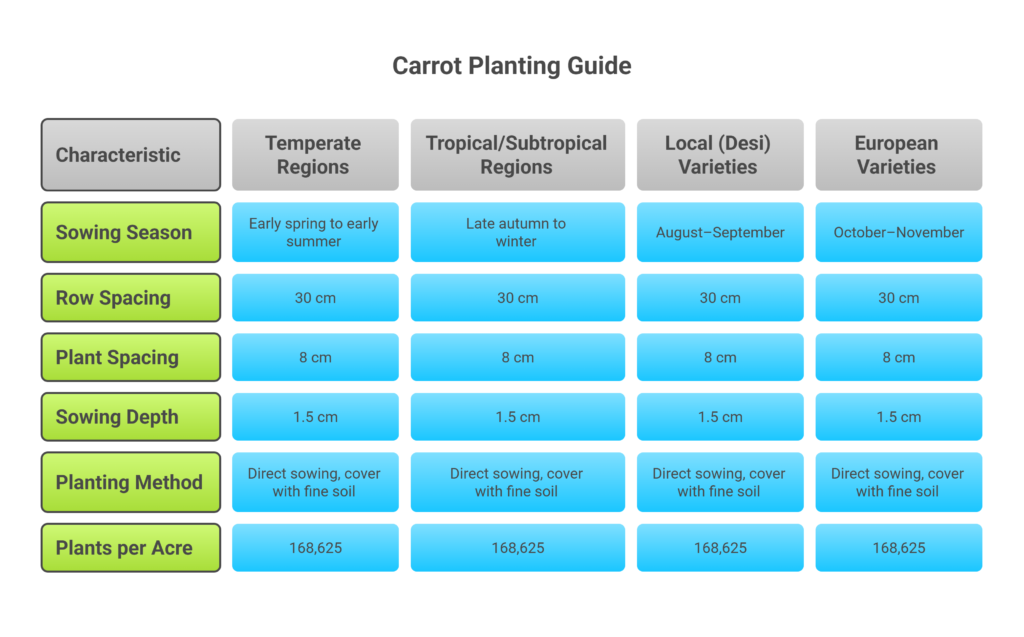
a). Planting Season
In temperate regions, carrots are typically sown from early spring to early summer, while in tropical or subtropical regions, the ideal sowing period spans late autumn to winter. For local (desi) carrot varieties, August–September is considered the optimal time for sowing, whereas European varieties perform best when planted during October–November. This seasonal alignment ensures optimal growth and yield based on regional climate conditions and cultivar requirements.
b). Spacing
For optimal growth, maintain a row spacing of 30 cm and plant spacing of 8 cm between individual plants. Seeds should be sown at a depth of 1.5 cm to ensure proper germination and healthy crop development. This spacing configuration promotes adequate resource distribution and minimizes competition among plants.
c). Planting Method
Carrots are planted by sowing seeds directly into the soil, lightly covering them with fine soil at a depth of 1–2 cm. For larger areas, a seed drill is recommended to ensure uniform sowing and consistent plant distribution, which enhances growth efficiency and crop uniformity.
d). Number of Plants per Acre
Based on the recommended spacing of 30 cm between rows and 8 cm between plants, the calculated plant density for optimal growth is approximately 168,625 plants per acre. This spacing ensures efficient use of space, promotes healthy root development, and maximizes yield potential.
Irrigation
Carrots require regular watering, initially irrigated every 3–4 days and reduced to weekly once plants establish. Drip or furrow irrigation is recommended to conserve water and prevent waterlogging. Consistent moisture is critical during germination, root formation, and enlargement stages.
A light irrigation should be applied immediately after sowing, followed by subsequent irrigations as needed. Overwatering can lead to short, light-colored carrots with larger diameters, and irrigation frequency depends on soil type, season, and variety.
Typically, irrigate every 4–5 days in summer and 10–15 days in winter, with only occasional watering during the rainy season. Avoid water stress during root development to prevent root cracking, ensuring optimal growth and quality.
Fertilizer and Manure
| Fertilizer/Manure Type | Application Rate | Notes |
| Organic | 15–20 tons/acre | Apply well-rotted farmyard manure during land preparation. |
| Chemical | ||
| Nitrogen (N) | 40–50 kg/acre | Split into 2–3 doses. |
| Phosphorus (P₂O₅) | 30–40 kg/acre | At planting |
| Potassium (K₂O) | 40–50 kg/acre | At planting |
| Micronutrients | As needed (if deficient) | Apply boron and zinc to improve root quality and yield. |
Potassium, often known as potash, is an essential nutrient for plants that is essential to the healthy growth of roots. By accelerating cell division and improving the movement of sugars and starches from leaves to roots, it encourages root elongation and branching and supplies the energy required for growth. In order to maintain a healthy root system, potassium also enhances the plant’s capacity to absorb water and vital nutrients like phosphorus and nitrogen.
Furthermore, it fortifies cell walls, boosting the plant’s resistance to environmental stresses including drought and salinity and strengthening roots against pests and diseases. Potash is a crucial part of balanced fertilization techniques since it is necessary for crops like root vegetables to have healthy, well-formed, and high-quality roots.
Weed Control
Effective weed management involves 2–3 rounds of manual weeding during the crop’s early growth stages, combined with organic mulching (e.g., straw or plastic) to suppress weeds and retain soil moisture. For broader control, pre-emergent herbicides like Pendimethalin can be applied to inhibit early weed growth, followed by post-emergent herbicides as required, ensuring minimal competition and optimal carrot development.
Pest and Disease Management
Common Pests
a). Carrot Fly
Carrot flies pose a serious threat to carrot crops, resulting in yellowing and wilting leaves as larvae feed on the roots. Adults deposit eggs near plant stems, and hatched larvae burrow into roots, causing decay and diminished crop output. Effective management includes using fine mesh netting (40–60 mesh) to block adult flies or planting decoy crops like radishes or onions to divert them.
Integrated approaches involve rotating crops with non-host plants (e.g., cereals), clearing post-harvest debris to disrupt breeding habitats, and applying organic neem-based deterrents to reduce egg-laying. Proactive monitoring and timely interventions during peak activity (spring and late summer) are vital to curb damage and maintain healthy root growth.
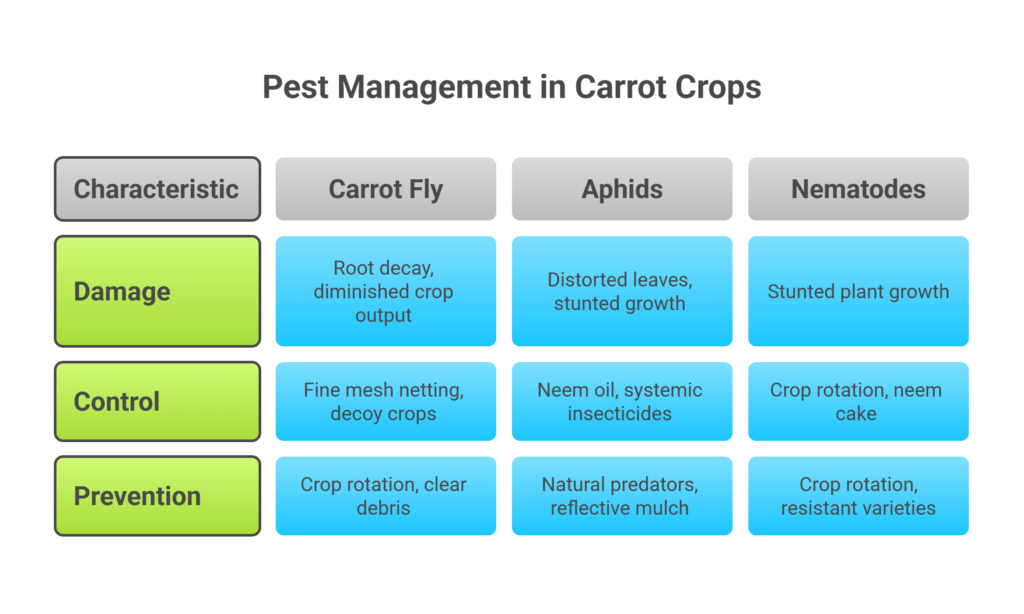
b). Aphids
Aphids, sap-sucking pests, infest carrot crops, causing distorted leaves, stunted growth, and honeydew secretion that triggers sooty mold. Control with neem oil (2–3 mL/L water) to disrupt their lifecycle or systemic insecticides (e.g., imidacloprid) for severe cases. Prevent infestations using natural predators (ladybugs), reflective mulch, and weed removal. Early monitoring minimizes outbreaks and ensures crop health.
c). Nematodes
Nematode infestations in carrot crops often lead to stunted plant growth due to root damage caused by these soil-borne pests. To manage nematodes effectively, adopt integrated practices such as crop rotation with non-host plants (e.g., cereals or marigolds) to disrupt their lifecycle, and cultivate nematode-resistant carrot varieties.
Additionally, apply neem cake at a rate of 0.5 tons per acre during sowing, as it acts as a natural nematicide while enriching soil fertility. These combined strategies suppress nematode populations, reduce root damage, and promote healthier plant development, ensuring sustainable crop productivity.
Common Diseases
a). Leaf spot
A fungal disease called leaf spot inhibits carrot development and photosynthesis by producing dark, round, yellow-haloed leaf lesions. Apply Mancozeb at a rate of 2 grams per liter of water to all leaf surfaces every 7 to 10 days or after a rainstorm. Combine drip irrigation, crop rotation, and the removal of contaminated material to reduce humidity. Combining early detection with other tactics reduces spread and safeguards yields.
b). Soft Rot
Soft rot, a destructive root disease caused by bacteria/fungi in waterlogged soils, causes mushy, foul-smelling decay, stunting or killing plants. Prevent it by improving drainage, using drip irrigation, removing infected debris, rotating crops, and sterilizing tools to curb pathogen spread and protect plant health.
Harvesting
Carrots should be collected when the roots reach the ideal size and color, which can range from 70 to 120 days following seeding, depending on the type. Use a fork or plow to remove the dirt around the roots, then carefully pull the carrots to harvest. Average yields under ideal conditions fall between 8 and 10 tons per acre, while there is room for increased production. Clean the soil from the roots after harvest, grade them according to size and quality, and store them in a cold, dark, and humid environment (such as 0–4°C with 95% humidity) to preserve freshness and prolong shelf life.
Cost of Investment Per Acre – Carrot Farming (Local Variety)
| S.N. | Categories | Cost (NRs.) |
| 1 | Land Preparation (plowing, levelling) | 15,000 |
| 2 | Seed rate per acre | 2,000 |
| 3 | Labor Costs (seed sowing) | 3,000 |
| 4 | Fertilizers and Manure | 7,000 |
| 5 | Irrigation | 5,000 |
| 6 | Weed Control (pre & post-emergence) | 2,000 |
| 7 | Pest & Disease Control | 5,000 |
| 8 | Harvesting | 2,000 |
| 9 | Miscellaneous Costs | 5,000 |
| Total | Total Cost | 46,000 |
Income from 1 Acre – Carrot Farming
| Particulars | Estimated Yield (kg) | Market Price (NRs/kg) | Total Income (NRs.) |
| Carrot yield | 8,000 | 15 | 120,000 |
Analysis of Carrot farming Profit
| Parameter | Value (NRs.) |
| Total Income | 120,000 |
| Total Cost | 46,000 |
| Net Profit | 74,000 |
The net profit from carrot farming in one acre is 74,000 NRs., yielding a robust 61.67% profit margin (calculated as 74,000120,000×100120,00074,000×100), with a cost-to-income ratio of 0.38, indicating only 38% of total income is allocated to production costs. The highest expenses are land preparation (15,000 NRs.) and fertilizers/manure (7,000 NRs.), while labor and irrigation contribute moderately. Generating 8,000 kg/acre at 15 NRs/kg results in 120,000 NRs. revenue, significantly exceeding the break-even yield of 3,067 kg (calculated as 46,000151546,000), with actual production 2.6 times higher, underscoring low financial risk and high profitability.

